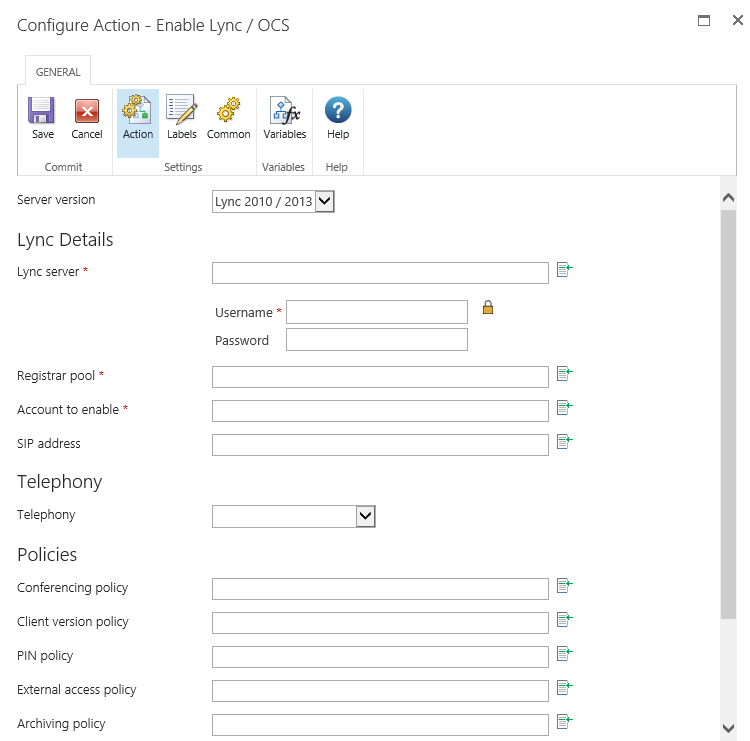
|
 |

|
 |

|
 |

|

|
* This topic applies to Nintex Workflow Enterprise Edition only.
The Enable Lync/ OCS action will enable OCS/LCS or Lync 2010/2013 for an existing Active Directory user account.
To use the workflow action:
-
Locate the action in Workflow Actions Toolbox (located on the left hand-side);
-
Click on the Category listings to reveal the actions; OR
-
Search for the action using a keyword.
-
Select the action, drag it onto the design canvas and drop it onto a design pearl.
Alternatively
-
Left-clicking the pearl, mouse-over Insert Action and then the Categories to reveal the actions, click the required action from the list.
To change the settings used by the action:
-
On the action’s title click the down arrow to activate a drop-down
-
Select Configure; OR
-
Double-click the action's icon.
For more information on the other options in the drop-down, please refer to the Getting started with the Nintex Workflow designer.

Action Settings
Server version
Select from Lync 2010, OCS 2007 or LCS 2005.
Server Version: OCS 2007/ LCS 2005
Active Directory Details
To configure the LDAP Path, refer to the LDAP Picker for more information.
- Username: Enter a username with the required permissions to provision a user on OCS/ Lync and access the LDAP Path entered.
- Password: Enter a password for the above username.
The username (sAMAccountName) of the Active Directory entry.
The SIP address for the Active Directory Account. E.g. sip:john.smith@mycompany.com
Check to enable LCS/OCS for the nominated Active Directory account. If left un-checked, the other properties will still be set.
Server Version: Lync 2010 / 2013
Note: The Lync mode remotely invokes the PowerShell command 'Enable-CsUser'.
Lync server
The name of the Lync server.
-
Username: Enter a username with the required permissions to access the Lync server.
-
Password: Enter a password for the above username.
Registrar pool
The fully qualified domain name (FQDN) of the Registrar pool where the users' Lync Server account will be homed.
Account to enable
The username (sAMAccountName) of the Active Directory entry.
SIP address
The SIP address for the Active Directory Account. E.g. sip:john.smith@mycompany.com
Telephony
Select the desired communication type. Chose from Audio/video disabled, PC-to-PC only, enterprise voice, remote call control, remote call control only.
Policies
-
Conferencing policy: The conferencing policy specifies the conferencing experience for participants.
-
Client version policy: The client version policy checks the SIP User Agent header to determine the client version.
-
PIN policy: The PIN policy provides a personal identification number (PIN) authentication to users who are connecting to Microsoft Lync 2010/2013 with IP phones.
-
External access policy: The external access policy determines whether or not your users can 1) communicate with users who have SIP accounts with a federated organization; 2) communicate with users who have SIP accounts with a public instant messaging and; 3) access Microsoft Lync Server 2010/2013 over the internet, without having to log on to your internal network.
-
Archiving policy: The archiving policy controls whether archiving for specific users is enabled or disabled for internal and external communications.
-
Location policy: The location policy automatically locates clients within a network. The Lync Server uses a Location Policy to enable Lync 2010/2013 clients for E9-1-1 during client registration. A location Policy contains the settings that define how E9-1-1 will be implemented. You can edit the global location policy and create new tagged location policies. A client obtains a global policy when not locations within a subnet with an associated location policy or when the client has not been directly assigned a location policy.
-
Client policy: The client policy determines the features of Microsoft Lync 2010/2013 which are made available to users.
Advanced
Domain controller
Connect to the specified domain controller in order to enable a user account
SIP address type
Instructs Lync Server to auto-generate a SIP address for the new user.
SIP domain
The SIP domain for the user account being enabled.
Authentication mode
Select from with default, basic, digest or negotiate.
For more information on the above parameters refer to http://technet.microsoft.com/en-us/library/gg398711.aspx